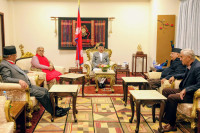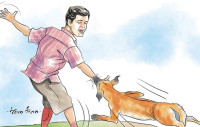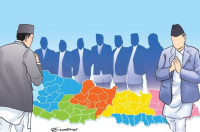Opinion
Beyond borders
There is no single ‘canonical’ method of talking about the poetic imaginings of South Asia
I was sent an invitation for a conference that is going to be held on 22-23 April. The topic “Poetic Imagining(s) of South Asia: Border and Nations” struck me immediately. In my proposal for the plenary I said, I would be happy to talk about “Poetic imaginings and flexible forms in South Asia”. But I was baffled particularly by the range of the topic. So I thought of making it managable by rephrasing it in the above manner. The topic and the subject evoke a number of problems that could be discussed only in a lengthy paper. But the modality of presentation as advised to me by Mallika Shakya, who is a faculty at the South Asian University, is that it should be presented in the form of a conversation with a South Asian poet and scholar.
There is no single ‘canonical’ method of talking about the poetic imaginings of South Asia. The subject cuts across time and geo-cultural spaces as well as ideologies. To take a few examples, the opening of EM Forster’s novel A Passage to India evokes the poetic grandeur of the Himalayas and the geo-cultural dimensions of South Asia, which is cited as an enunciation of the colonial poetic imaginings of this region, the epic sublime. That description differs from the Sanskrit poet Kalidas’s evocation of the Himalayas.
Poetic evocations of the geo-cultural spaces are not limited to big texts. Poetic imaginings transcend various forms of borders and challenge epistemological structure and political domination. Poetic sharing and traditions exist either as singular transmissions of traditions or as double binds.
The first is easier to see than the second, which exists through choices. Which form of poetic imagining is workable, and why does the other not work the same way? Why do similar poetic traditions offer variations? And why does one still accept the variations? What factors bind you to the poetic imaginings as expressed in printed texts or oral forms? Such questions about double binds beg answers.
The same subject interpreted in different ways by poets of different social positioning also evokes the double bind perception of poetic imagining. Kabir, the Fakir poet, interprets the same faith, the same deities like the canonical poets but in a different manner. But both forms of interpretations revolve round the same poetic and knowledge content, which is a unique form of double bind of poetic imaginings.
But what we can see is that poetry in its folk, classical, modern and other forms can be the most productive and flexible subject of sharing and interchange in South Asia. Its continuum, and openness to change makes poetry the most versatile cultural subject of discourse. But I want to focus mostly on Nepali poetry and its features that it shares with other poetic traditions in the region.
Poetry is the most versatile genre of literature in Nepal. Nepali poetry is used to project a sense of nation and borders not least in the sense of its erasure when it comes to sharing the printed texts and oral stories. I have in mind the Ramayana, an epic poetry that remains the most shared poetic text in Nepal and among the Nepali speakers in India. Poetry has fluid borders, which to my mind constitute the most important aspect of sharing creative culture in South Asia. I am a strong believer in the practice of sharing, which explains the bonding established by epic or short poetry in the region. A Nepali speaker born and brought up in the hills of Nepal, I felt the power of poetic sharing when I grew up listening to my mother recite Ramayana—that was translated in Nepali from Sanskrit Adhyatma Ramayana by Bhanubhakta, Kashirama Das’s Bengali Mahabharata and Tulsidas’s Ramayana. This unique melange, though not perfect in literary sense, has shaped a sense of the continuum of many people in this region.
The second aspect of poetry in Nepali society is the folkloristic influence. Folk poetry strongly influenced Nepali poetry. But the folk singers, the gandharvas who play sarangi used the standard verses to sing by giving them a folk reading. They have used Bhanubhakta’s Ramayana for that purpose.
The folklore poetry has survived mostly through singing. The troubadours sing history, geography, individual anguish and joys. I find this topic interesting for discussion in a session focussed on the use of poetry. But the massive use of folk songs, their style and melody in visual formats has become a strong phenomenon in Nepal, and I guess, elsewhere in South Asia.
The South Asian poetry sharing has another dimension, which is literary and critical in a certain sense. The major movements in poetry in Nepal have overtly or covertly shared certain influences with the poets of South Asia. I would mention the Romantic Movement called chayabad in the Hindi sphere, a subject productively discussed by Francesca Orsini in her book The Hindi Public Sphere (2002). In Nepal it was/is called swochandatavad.
More complex responses to sharing emerged after a form of poetry called ‘modernist’ was introduced in Nepal. This form of poetry appeared to share a number of features with the South Asian poetry. But this opened an entirely different perception of angst or city or modern crisis largely related to the city culture. Interestingly, Nepal’s largest city is Kathmandu. When the modernist Nepali poet wrote about the city-induced angst, Kathmandu was a clean, beautiful and cultural city. That contradiction, that aporia, was an indicator of a certain process of using modernism in the creation of an atmosphere of the poets’ minds.
I have seen and heard how poetic imaginings find shape in flexible and spontaneous modes of double binds and expressions. I always look forward to presenting my views and experiences as a writer and interpreter of poetry, a lover of folklore, and theatre, and most importantly, as someone who believes in the power of poetic imaginings in and outside the geo-cultural contexts.




 14.12°C Kathmandu
14.12°C Kathmandu









